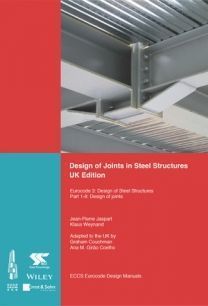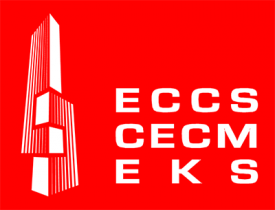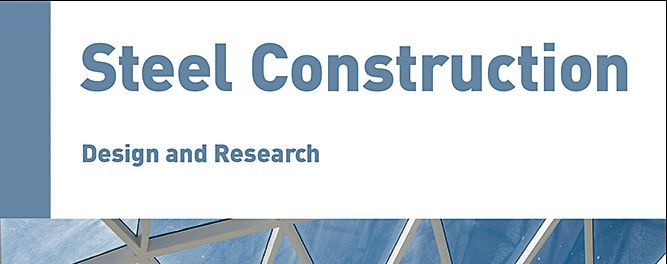1. Introduction
This introduction presents an overview of the key concepts discussed in the subsequent chapters of this book. The book addresses design methodology, structural analysis, joint behaviour and design checks. It provides designers with practical guidance–and tools for the design of steel joints. The book explores the importance of structural joints on the response of steel structures and to show how the actual behaviour of joints may be incorporated into the structural design and analysis process. It illustrates the possibilities of producing more economical structures using the new approaches offered in the European code of practice for the design of steel structures, Eurocode 3 (EN 1993) as far as structural joints are concerned. Recognising that most joints have an actual behaviour which is intermediate between that of pinned and rigid joints, EN 1993 offers the possibility to account for this behaviour by opening up the way to what is presently known as the semi-continuous approach.
2. Structural Analysis and Design
The design of a frame and its components is a two-step procedure involving a global frame analysis followed by individual cross section and member design checks. Traditionally, frame analysis is performed by assuming joints as perfectly pinned or perfectly rigid. It is important that the joints are subsequently designed and detailed to behave in a way that corresponds to the analysis assumptions. This chapter focuses on joint modeling, joint classification, joint idealization and ductility classes. Joint behaviour affects the structural frame response and, therefore, has to be modelled, just like beams and columns are modelled for frame analysis and design. The chapter introduces three different types of joint modelling: simple, semi-continuous and continuous. One of the most simple idealisations possible is the elastic-perfectly-plastic one. For beam and column sections, deemed-to-satisfy criteria allow the designer to determine the class of the sections and therefore the type of global frame analysis which can be considered.
3. Connection with Mechanical Fasteners
The basic elements of joints in steel structures are mechanical fasteners like bolts or pins. In steel construction, the most typical mechanical fasteners to connect plates or profiles are bolts, or more precisely: bolt assemblies (sets) including the bolt itself, a nut and one or more washers. The two main categories, dependent on the loading applied to the bolt, are shear connections and tension connections. In bolted connections, independently of the type of loading, the bolt holes must fulfil certain requirements with respect to minimum and maximum spacing between the holes, end distances and edge distances. This chapter discusses the design of the following connections: bolted lap joints, bolted T-stubs, gusset plates and long joints. In bolted connections, independently of the type of loading, the bolt holes must fulfil certain requirements with respect to minimum and maximum spacing between the holes, end distances and edge distances.
4. Welded Connections
Fillet welds and butt welds are widely used in construction. They represent 80% and 15%, respectively, of all welds found in structures. For the remaining five per cent, plug and fillet all round welds are mostly used. Butt welds are used between adjacent plates in so-called butt and tee-joints. Contrary to a butt weld, a fillet weld requires no preparation of the plates to connect. This is an important feature in terms of fabrication costs. Fillet welds are applied to the surface of the connected plates; they exhibit an approximately triangular shape. Fillet welds all round is a term used to describe fillet welds in circular or elongated holes. For weld design, three fundamental assumptions are usually made: the welds are homogeneous and isotropic; the connected elements are rigid and their deformations are negligible; and only nominal stresses due to external loads are considered.
5. Simple Joints
Simple joints are assumed to transfer no bending moments and should be designed accordingly. This chapter presents various joint configurations where simple joints are likely to be used. They are grouped in five categories: beam-to-column joint configurations; beam-to-beam joint configurations; beam splice joint configurations; bracing joint configurations; and column base joint configurations. The chapter provides design rules for beam-to-column, beam-to-beam configurations and column bases. The design rules are based on the resistance formulae provided by EN 1993-1-8, at least as far as information is available. The design recommendations for simple joints relate to the “hinge model”. The chapter presents specific design requirements ensuring safety for each of the connection types considered. The design methods are intended for joints subjected to predominantly static or quasi-static loading. The design of simple joints reduces to the limitation of the applied shear force to the shear design resistance, provided that ductility and rotation requirements are satisfied.
6. Moment - Resisting Joints
Moment-resisting joints is a general term used to cover all joints which transfer significant bending moments between the connected members, but also shear and/or axial forces. These joints may be rigid or semi-rigid, in terms of stiffness, and may exhibit a full or a partial strength resistance level. This chapter first addresses the characterisation of the mechanical response of individual components covered by EN 1993-1-8. Then, it discusses the assembly procedure problem, successively in terms of resistance, stiffness and deformation capacity. The chapter presents the application of the component approach to specific joints. it considers the following joint configurations: steel beam-to-column, beam-to-beam and beam splices; steel column splices; and column bases. In EN 1993-1-8, components are characterised by means of three specific design properties: the elastic stiffness; the plastic resistance; and the (plastic) deformation capacity.
7. Lattice Grider Joints
EN 1993-1-8 gives detailed application rules to determine the static design resistances of uniplanar and multiplanar joints in lattice structures composed of circular, square or rectangular hollow sections. Also, uniplanar joints in lattice structures composed of combinations of hollow sections with open sections are covered to a certain extent. This chapter presents a short introduction to the design of hollow section joints. The design resistance of joints between braces and chords in lattice structures are expressed in terms of design axial and/or moment resistances of the brace members, or, in some cases, in terms of design axial resistances of the chords. The design formulae for CHS chord failure modes are based on the so-called Ring Model. Due to the unequal stiffness distribution the brace can fail by fracture close to the weld, local yielding or buckling.
8. Joints under varoius loading Situations
EN 1993 adopts the component method as a reference for the design of joints in steel structures. This chapter reviews recent developments on the application of the component method to various loading situations, including fire, earthquake, impact and explosion. Guidelines on how to apply the component method for the evaluation of the initial stiffness and the design moment resistance of steel and composite joints are given in EN 1993-1-8. The component method could be a solution to overcome this “fullstrength” obligation. Indeed, the component method has the potential to predict the response of joints under cyclic loading but for that, it is required to know the behaviour of each component under such loading conditions. The application of the component method to joints subjected to axial forces or combinations of axial forces and bending moments.
9. Design Strategies
This chapter describes the various approaches that can be used to design steel frames with due attention being paid to the behaviour of the joints. For the design of steel frames, the designer can adopt one of the following design approaches: traditional design approach and integrated design approach. In the traditional design approach, any joint is assumed to be either simple or continuous. In the integrated design approach, the global analysis is carried out taking into account the presumed real joint response. With respect to joint design basically two different strategies can be identified when targeting minimum cost steel structures: simplification of the joint detailing; and reduction of member dimensions. In general both strategies would benefit from the use of semi-rigid joints. Economy studies in various countries have shown possible benefits from the use of semi-rigid joints. More significant savings can be achieved when moment connections are optimised in view of economy.



